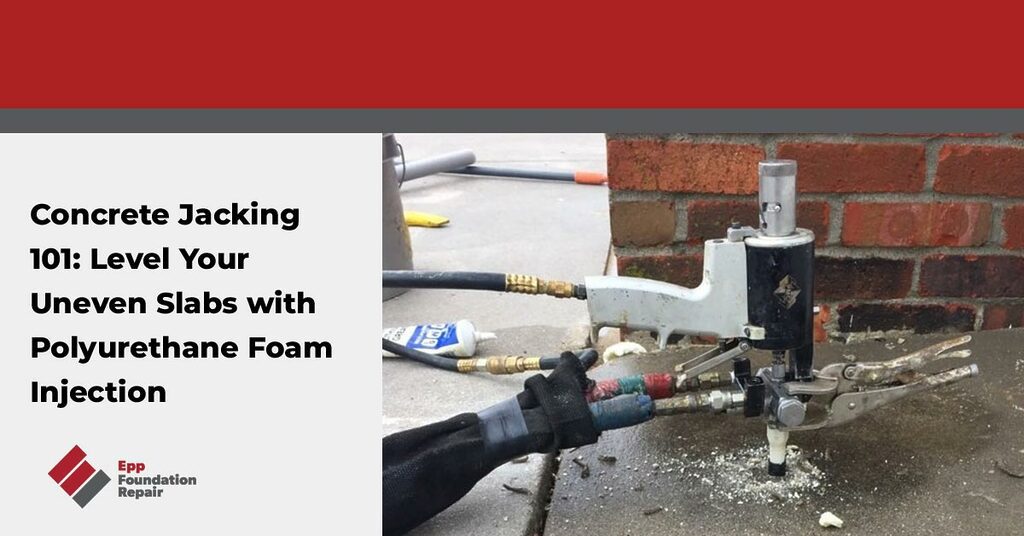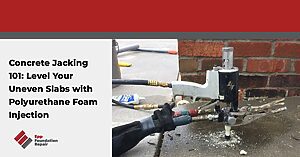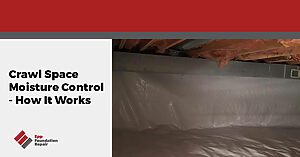If you have an uneven concrete surface, then concrete jacking is the key to fixing it. Find out why your slab may be uneven and how polyurethane foam injection can permanently level it. And if you’re thinking about jacking the concrete yourself, keep reading to find out why you should reconsider.
What Is Concrete Jacking?
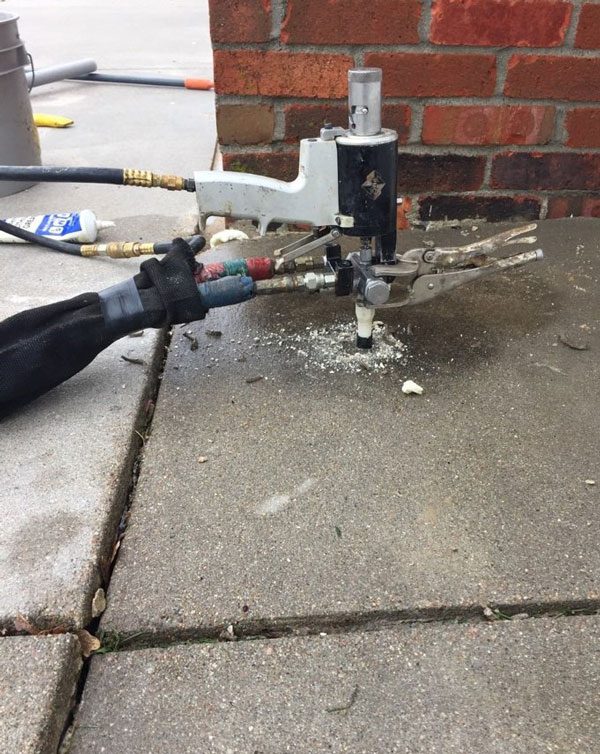
Concrete jacking is the raising or lifting of a concrete slab to level it out. Other common trade names for concrete jacking include:
- Concrete leveling
- Concrete lifting
- Concrete raising
- Slab jacking
- Polyjacking
Concrete jacking is a cost-effective repair method for cracked and sunken surfaces like driveways, sidewalks, porches, garage floors, and foundations. Instead of replacing the surface, you can fill the void below, raise the slab, and patch any cracks, creating a smooth, safe, attractive surface.
Why Do Concrete Slabs Crack and Become Uneven?
Before deciding to repair your concrete slab, it is best to understand why it was damaged in the first place. Common factors include:
- Poor site preparation – If the soil beneath the slab is not compacted properly, the soil will shift over time, causing the slab to settle.
- Expansion and contraction of the soil – Clay soil tends to swell during rainy seasons and contract during dry seasons. The repeated motion of expansion and contraction causes your slab to shift.
- Poor water drainage – Waterlogged soil causes the soil beneath the slab to swell and shift, affecting the slab above.
- Erosion – When the soil erodes, it leaves voids beneath the slab, which causes the slab to shift and sink.
- Invasive tree roots – Powerful root systems can crack and shift your concrete slab, even if the tree is several feet away.
- Uneven weight distribution – If a heavy object, like a car, is consistently placed on one side of the concrete slab, the uneven weight distribution will eventually cause the slab to sink on one side.
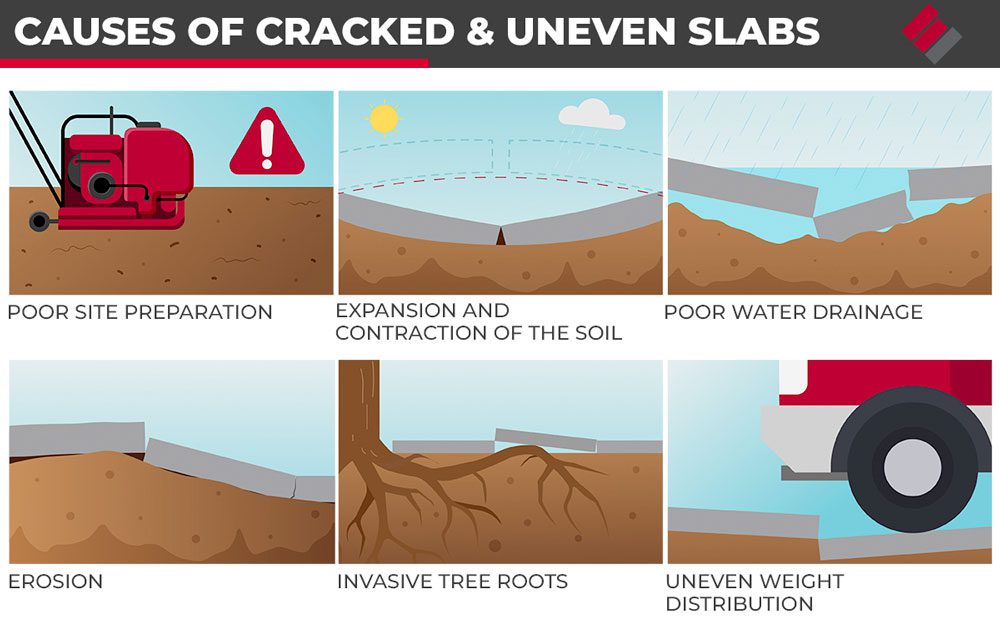
An expert can help you determine the cause of the damage to your concrete slab and how to prevent future damage after the repair.
Why Should I Consider Jacking My Concrete?
Cracked and uneven concrete slabs are more than just eyesores. Consider some of the other problems associated with uneven concrete.
- Reduced home value – If you want to sell your home, unsightly concrete will reduce its value.
- Dangerous tripping hazard – Uneven concrete can lead to trips and falls. Young children, people with disabilities, and older adults are especially susceptible to trips and falls. In serious cases, this liability can lead to an injury claim against your homeowners’ insurance if someone gets hurt.
- Poor water drainage – Uneven slabs can cause water to pool or even run towards the home’s foundation. Poor drainage can further damage the driveway and put your home’s foundation at risk of cracking, flooding, and settling.
- Uneven flooring – If you want to finish your basement or turn your garage into a workspace and plan to install hardwood or laminate flooring, an uneven slab can put a damper on your plans. An uneven slab means an uneven floor, and you don’t want your new investment to have dips or slopes.
What Is Polyurethane Foam Injection and How Does It Work?
Polyjacking is a method of concrete jacking that uses polyurethane foam. This polymer compound creates a high-pressure foam that fills the void below the concrete slab and is strong enough to raise it while compacting the soil below. Here is how it works:
- Inspection: The slab and the surrounding area are inspected to determine the reason for the damage. Then, a plan is created to determine the best way to raise the slab.
- Drilling: Small dime-sized holes are drilled through the concrete, and ports are inserted at the injection sites.
- Injection: The polyurethane foam is injected below the slab with special equipment that monitors and regulates the foam’s injection.
- Lifting: The foam rapidly expands, compacting the soil, filling voids, and raising the slab. The professional will carefully inject the right amount of foam to avoid cracking or over-lifting the slab.
- Cleanup: Once the slab is leveled, the drilled holes are filled with concrete that matches the existing slab as much as possible.
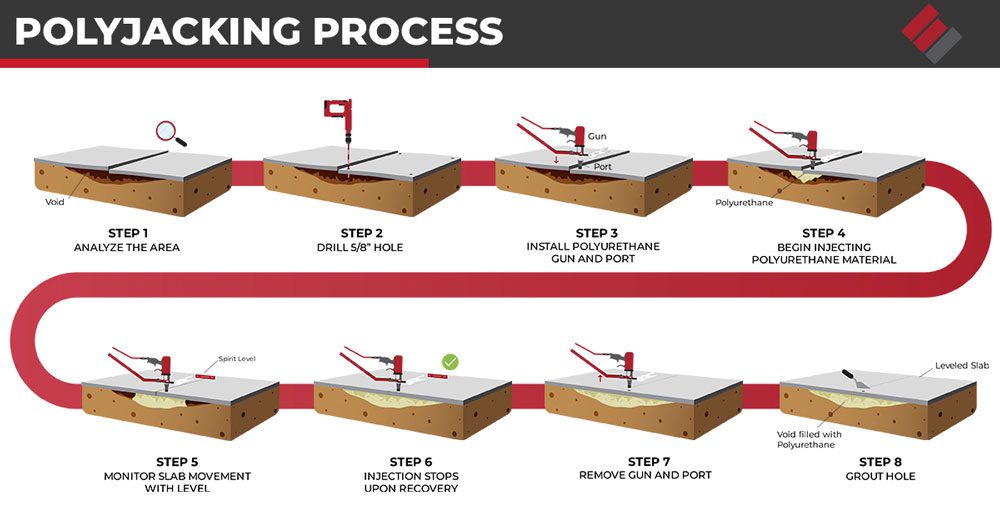
What Are the Benefits of Using Polyurethane Foam?
Polyurethane foam injections have many advantages. Here are the top seven advantages:
- Fast Acting – Polyurethane foam cures after just 15 minutes from the injection time. That means you can use the space almost immediately. There is no need to put your life on pause.
- Lightweight – Most slabs become uneven because of issues with the soil. This lightweight foam prevents unnecessary weight from being added to the soil. Instead, it compacts the soil, preventing soil settlement.
- Cost-Effective – Repairing the existing concrete slab is cheaper than replacing it. In some cases, polyjacking can save you up to 50% compared with slab replacement.
- Minimally invasive – No excavation is needed to raise the slab. With just a few small holes at the injection sites, you may not even remember we were there.
- Environmentally Friendly – Polyurethane foam is inert, meaning that it does not move or leach into the surrounding soil or water.
- Waterproof – No need to worry about the foam eroding or washing away.
- Permanent – In most situations, polyurethane foam is permanent. This impermeable material adheres to the concrete surface and forms a solid mass that will not break down.
What Are the Potential Applications of Polyurethane Foam?
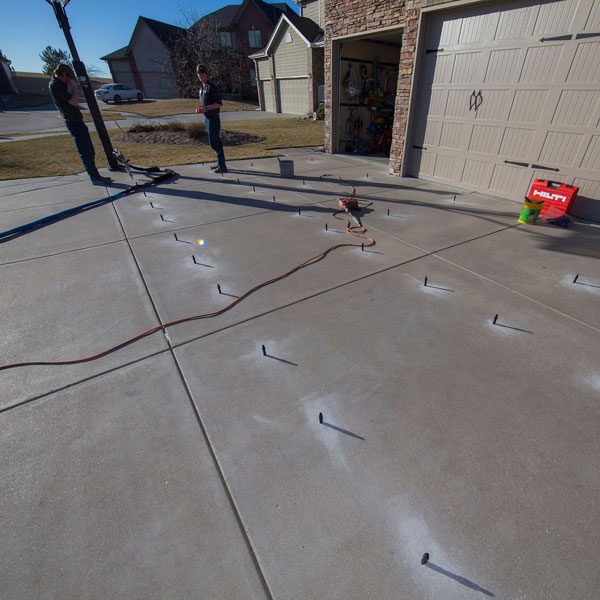
Polyurethane foam can jack up almost any uneven concrete surface. Here are some examples:
- Sidewalks
- Driveways
- Concrete steps
- Garage floors
- Warehouse floors
- Basement floors
- Pool decks
- Porches
- Patios
Clearly, the possibilities are numerous. However, it is worth noting that not all uneven concrete surfaces can be leveled with jacking. Concrete jacking can raise a slab but cannot lower it. If the slab needs to be lowered, the only solution is removal and replacement. Also, if a building’s foundation faces differential settlement, polyjacking will not be sufficient. In such cases, it will require underpinning, which involves using push or helical piers.
Is Polyjacking Better than Mudjacking?
Put simply, yes, polyjacking is better than mudjacking. Some even call it the “Jetson’s’ approach because of the superiority of this modern solution. Consider the following factors:
- Speed – Polyurethane foam only takes 15 minutes to cure, unlike the cement slurry used in mudjacking, which can take 24 to 72 hours.
- Longevity – Lightweight polyurethane foam is a permanent solution that stabilizes the concrete and soil. In contrast, mudjacking uses a heavy slurry that can burden the soil and is susceptible to erosion, moisture, and freeze-and-thaw cycles, leading to eventual failure.
- Appearance – Mudjacking requires heavier equipment and larger holes for installation. Polyjacking requires fewer resources and smaller holes, resulting in a less invasive and cleaner finish.
Still curious about mudjacking and how it compares to polyjacking? For more information, see Mudjacking vs Polylevel.
Can You DIY Concrete Jacking?
Some have tried and succeeded, at least temporarily, in DIYing their concrete leveling. However, we cannot honestly recommend DIY concrete jacking. Here is why:
- Experience – Concrete leveling takes years of hands-on experience to acquire dependable precision. Our years of experience have taught us how to recognize the causes of uneven concrete slabs, which materials and techniques work best, where and how to inject the polyurethane foam to raise the slab to the ideal level, and when to look for a different, more permanent solution.
- Cost – Polyjacking requires very costly specialty equipment. Using the wrong tools may further damage your slab, creating the need for more expensive repairs. And this is aside from the extra time and energy expended trying to fix the slab yourself.
- Risks – If you try to level your slab, you risk doing more harm than good. Drilling holes in the wrong spot or not sufficiently filling the void below will crack the concrete. And with the rapid expansiveness of polyurethane foam, you risk over-injecting the foam and over-lifting the slab. In that case, you will need to replace the entire slab.
Don’t hesitate to schedule your free consultation today. Our concrete jacking services have helped customers throughout Nebraska, Iowa, Kansas, and Missouri. We are ready to serve you.

